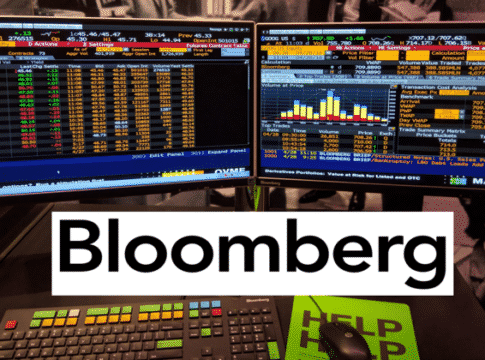Bloomberg Net Zero Carbon Emissions Pledge
Bloomberg, the global information and news company, had pledged to reduce its carbon emissions and become net zero by 2025.
While it focuses on emissions reductions, it also plans to make more investments in projects that produce carbon credits on the road to net zero.
In 2021, Bloomberg began buying and retiring carbon credits to offset its business travel emissions. But starting in 2025, it will expand this effort to cover all remaining carbon emissions.
Bloomberg Net Zero Carbon Emissions Targets
Bloomberg’s target emissions reductions follow the science-based approach by SBTi (Science-Based Targets initiative).
Its short-term targets aim for an 80% reduction in its Scope 1 and 2 emissions. At the same time, it targets to reach a 20% reduction in its Scope 3 emissions by 2030 from a 2018 baseline.
Here’s Bloomberg’s progress toward its net zero carbon emissions goals as seen in its 2021 Impact Report.
Bloomberg’s science-based targets aim to reduce:
Scope 1: Direct GHG emissions from direct use of fuel, including natural gas, generator oil, refrigerants, and aircraft fuel.
Scope 2: Indirect GHG emissions associated with consumption of purchased electricity and steam.
Bloomberg’s Scope 3 emissions refer to all other indirect GHG emissions. These include:
business travel, publishing operations, global logistics, paper usage, and landfill waste generation.
Bloomberg emissions by activity
Energy consumption generates most of Bloomberg’s emissions (72.5%) as shown in the chart.
In 2021, energy consumption accounted for an even greater share of the firm’s total emissions. While emissions from publishing operations fell and business travel remained lower.
Bloomberg Carbon Emissions by Activity
With that, Bloomberg’s top priority with its net zero emissions is reducing its energy use. It keeps track of the kWh consumption per employee as a measure of its energy efficiency.
Bloomberg is a member of RE100. It’s a global initiative of influential businesses committed to using 100% renewable electricity.
The media company pledged to get 100% of its electricity from renewable sources by 2025.
In 2021, Bloomberg secured 176 million kWh of renewable energy, an increase of 10 percent from 2020. This amount is from its 9 on-and off-site solar, wind, and hydropower projects.
This sourced renewable energy represents 51.2% of the firm’s purchased energy.
To date, Bloomberg’s renewable projects have generated 592 million kWh of energy.
Moreover, part of Bloomberg’s path to net zero emissions is to cut the environmental impact of its facilities. In particular, it includes its buildings and data centers.
The company invests in green-certified office spaces. 80% of its employees work in offices certified by Leadership in Energy and Environmental Design (LEED) or BREEAM standards.
In 2021, Bloomberg had 36 certified projects on six continents, with 5 more in progress.
When it comes to its data centers, the firm has a goal to have a 5% improvement in energy efficiency across its data centers versus a 2018 baseline.
In 2021, it managed to achieve a 2% improvement in energy efficiency based on Power Usage Effectiveness (PUE). It’s a measure of how efficiently a data center uses energy.
PUE is the ratio of the energy used by the facility to the energy delivered to the computer equipment. And a lower PUE value is better.
Carbon credits: A means toward net zero emissions
Business travel has represented a significant part of Bloomberg’s total emissions. But the pandemic restrictions lowered business travel.
In 2021, Bloomberg traveled 31% fewer miles than in 2020 and its associated emissions fell by about 20%. The firm’s 2021 travel activity was 86% lower than its pre-pandemic level in 2019.
But as the pandemic diminishes and regular business dynamics resume, business travel will be up. And so, it will be a key area of focus as Bloomberg work to reach its 2030 net zero emissions reduction targets.
In relation to this, Bloomberg is now buying and retiring carbon credits to offset its travel emissions.
The firm worked with climate solutions company the South Pole to buy carbon credits. These credits will support climate action projects in Brazil, Cambodia, and the Democratic Republic of Congo.
The number of credits will cover all of Bloomberg’s travel emissions for the next 3 years. The selected projects have co-benefits that align with the UN Sustainable Development Goals.
Plus, it offers the following carbon credits benefits:
Water filters in Cambodia:
This project supports locally-made Ceramic Water Purifiers that provide clean water to communities. With a filter in their home, families no longer need to boil their water to make it safe to drink.
Forest conservation in Brazil:
This refers to the Envira Amazonia Tropical Forest Conservation project in Brazil’s Amazon basin. It protects 39,300 hectares of tropical forest from logging and cattle ranches.
Forest conservation in the Democratic Republic of Congo:
This one is the Isangi Forest Conservation project in the Democratic Republic of Congo. It protects over 187,000 hectares of one of the Earth’s most biodiverse rainforests from deforestation.
Finally, Bloomberg’s publishing operations are one of its major carbon emitters. It accounted for 13% of total company emissions.
In 2021, it published three magazines that consumed 5 million pounds of paper. This generated 8,647 metric tons of CO2e. This represents a 33% reduction versus 2020 due to reducing the total number of print magazines by 46%.
To mitigate this emission, Bloomberg is employing these strategies:
Recycled paper: printing on 100% recycled-content paper
FSC certification: Forest Stewardship Council or FSC-certified paper for all magazines
Efficient printing: improve processes to limit paper waste during production
Regional printing and distribution: to reduce emissions
Digital publishing: most impactful to reduce publishing activities emissions.
Bloomberg aims to reach net zero both via emissions reductions and business efficiencies.
Emissions reductions are a priority for the company. But it will also invest in projects that create carbon credits to offset emissions.
So along with over 800 companies, Bloomberg committed to reaching its net zero emissions goals through various means.
The post Bloomberg Net Zero Carbon Emissions Pledge appeared first on Carbon Credits.



